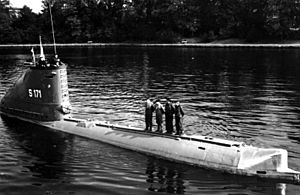German submarine U-2354 facts for kids
class="infobox " style="float: right; clear: right; width: 315px; border-spacing: 2px; text-align: left; font-size: 90%;"
| colspan="2" style="text-align: center; font-size: 90%; line-height: 1.5em;" | 
|} The German submarine U-2354was a special type of submarinecalled a Type XXIII U-boat. It was built for Nazi Germany's navy, the Kriegsmarine, during World War II. The order to build this submarine was placed on 20 September 1944. Its construction began on 14 October 1944 at the Deutsche Werft AG company in Hamburg, Germany. The U-2354was launched into the water on 10 December 1944. It officially joined the navy on 11 January 1945, under the command of a leader named Hans-Dieter Wex.
Contents
| History | |
|---|---|
| Name | U-2354 |
| Ordered | 20 September 1944 |
| Builder | Deutsche Werft AG, Hamburg |
| Yard number | 508 |
| Laid down | 14 October 1944 |
| Launched | 10 December 1944 |
| Commissioned | 11 January 1945 |
| Fate |
|
| General characteristics | |
| Class and type | Type XXIII submarine |
| Displacement |
|
| Length |
|
| Beam |
|
| Draught | 3.66 m (12 ft) |
| Installed power |
|
| Propulsion |
|
| Speed |
|
| Range |
|
| Test depth | 180 m (590 ft) |
| Complement | 14–18 |
| Armament |
|
| Service record | |
| Part of: |
|
| Commanders: |
|
| Operations: | None |
| Victories: | None |
What Was the U-2354 Like?
The U-2354 was part of the Type XXIII class of U-boats. These submarines were smaller than many others used in World War II.
Size and Weight
When the U-2354 was on the surface of the water, it weighed about 234 tonnes (230 long tons). When it was underwater, it weighed a bit more, around 258 tonnes (254 long tons). The submarine was about 34.68 m (113 ft 9 in) long from end to end. Its widest part was about 3.02 m (9 ft 11 in). The bottom of the submarine sat about 3.66 m (12 ft) deep in the water.
How It Moved
The U-2354 had different engines to help it move.
- It used a diesel engine for power when on the surface.
- It had two types of electric motors for moving underwater. One was a standard motor, and the other was a special "silent running" motor. This silent motor made it harder for enemies to detect the submarine.
Speed and Range
The submarine could travel at different speeds:
- On the surface, its top speed was about 9.7 knots (18.0 km/h; 11.2 mph).
- Underwater, it could go faster, reaching about 12.5 knots (23.2 km/h; 14.4 mph).
- For long journeys underwater, it could travel 194 nautical miles (359 km; 223 mi) (about 359 kilometers) at a slower speed of 4 knots (7.4 km/h; 4.6 mph).
- On the surface, it could travel much further, about 2,600 nautical miles (4,800 km; 3,000 mi) (about 4,815 kilometers) at 8 knots (15 km/h; 9.2 mph).
How Deep It Could Go
The U-2354 was designed to dive to a depth of about 180 m (590 ft) (about 590 feet). This was its "test depth," meaning it was safe to operate at this depth.
Crew and Weapons
The submarine needed a small crew of about 14 to 18 sailors to operate it. For defense, the U-2354 had two torpedo tubes at the front. It could carry two torpedoes, which were powerful underwater weapons. Unlike some larger submarines, this type of U-boat did not have a deck gun.
What Happened to U-2354?
The U-2354 did not see much action during the war. On 9 May 1945, near the end of World War II, the submarine surrendered. This happened in Kristiansand, a city in Norway.
Later, on 29 May 1945, the U-2354 was moved to Loch Ryan, Scotland, in Northern Ireland. After the war ended, many German U-boats that had surrendered were sunk by the Allied forces. This operation was called Operation Deadlight. The U-2354 was one of 116 submarines chosen to be sunk.
On 22 December 1945, the U-2354 was towed out to sea. It was then sunk by gunfire from a British destroyer ship named HMS Onslow. The remains of the U-2354 now lie underwater at a location marked by these coordinates: 56°00′N 10°05′W / 56.000°N 10.083°W.
See also

